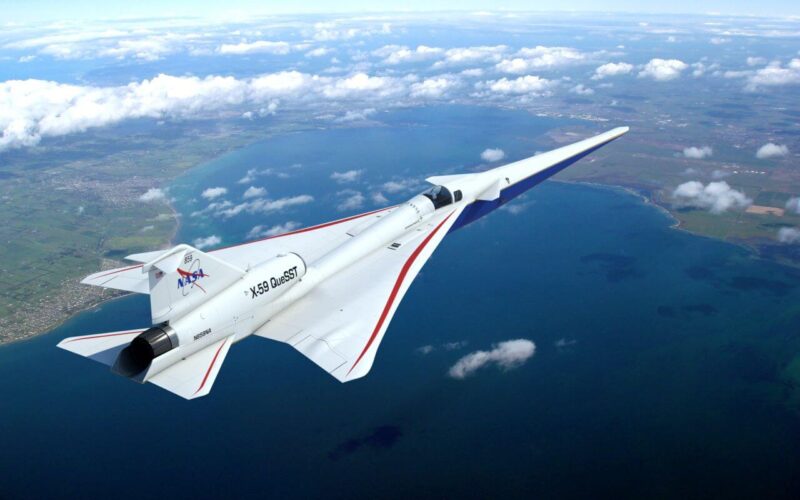Following years of research and design engineering, NASA believes it has come up with a solution on how to reduce a sonic boom. The agency has been working with defense contractor Lockheed Martin to develop the technology that can overcome current noise restrictions for commercial supersonic flight over land and pave the way for establishing a new market of air travel. The project is known as X-59 Quiet Supersonic Technology or QueSST and, according to NASA, it is already taking shape – with assembly work ramping up towards the eventual first flight of the supersonic jet scheduled in 2021.
The X-59, also known as the Low Boom Flight Demonstrator (LBFD), is currently being built and assembled at Lockheed Martin’s Skunk Works factory in Palmdale, California. Once built, the X-59 will serve as an experimental single-pilot aircraft capable of flying faster than the speed of sound. The aircraft will be put through a series of performance tests, including flight trials, before being deployed on flyovers over select U.S. communities to gather data on how effective the new low-boom technology is in terms of public acceptance.
In April 2018, Lockheed Martin Aeronautics was awarded a $247.5 million contract by NASA to design, build and test a quieter supersonic aircraft – one that produces a low rumble when it breaks the sound barrier, rather than the disruptive boom currently associated with supersonic flight. The factory, where the X-59 is to take shape, is the same that saw the birth of Lockheed’s famed SR-71 Blackbird – long-range, high-speed and high-altitude surveillance plane that was capable of flying at a speed of Mach 3.3 (2,510 mph) at an altitude of 85,000 feet and to date is known as the fastest plane in history, The National Interest explains.
According to NASA, the X-59 QueSST is designed to be capable of flying at a speed of Mach 1.23 (940 mph) at a cruising altitude of 55,000 feet; its new wing and hull design will produce a sonic boom of only 75 Perceived Level decibels (PLdB), which researchers believe will be acceptable for unrestricted supersonic flight over land. For comparison, the Concorde was capable of reaching Mach 2.04 (1,550 mph) at 60,000 feet with a sonic boom noise level of 105 PLdB.
What flies faster than the speed of sound, but doesn’t produce sonic booms? The X-59 QueSST. Short for Quiet SuperSonic Technology, our experimental aircraft is currently taking shape on a factory floor & could soon revolutionize supersonic air travel: https://t.co/9ZnRg15OX2 pic.twitter.com/WE0Hk4TEjk
— NASA (@NASA) October 9, 2019
So at what stage is the X-59 QueSST project now? Having completed the Critical Design Review (CDR) in September 2019, the next key test for the X-59 will come in December 2019, when an independent review board will present their findings and issues to be addressed from the CDR, at which point a recommendation will be made on whether the company should go ahead with the project. “The CDR showed us the design was mature enough to continue into the next phase and essentially finish the assembly,” said Craig Nickol, NASA’s project manager for the X-59 in a statement.
NASA is targeting the first flight of the X-59 QueSST in 2021 with initial trial flights of the jet – aimed at proving performance and safety (also known as “flight envelope expansion”) – to take about nine months. Based on the success of these flights, the agency will officially take delivery of the experimental aircraft from Lockheed Martin. The next phase is acoustic validation, expected to run through spring of 2023, which will involve flying the X-59 over select U.S. cities and collecting data about community responses to the noise produced by low-boom flights. The data will be delivered to U.S. and international regulators for consideration on new sound-based rules regarding supersonic flight over land. The Federal Aviation Administration (FAA) banned commercial aircraft flying faster than the speed of sound, or Mach 1, to pass over land in 1973.

